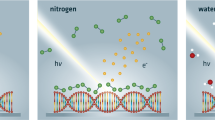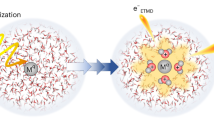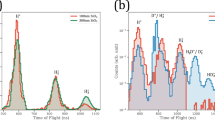Abstract
IT has been suggested1,2 that the action of, for example, γ-rays on water leads primarily to the formation of radiation-produced electrons and the corresponding positive holes and that these electrons, and possibly also the holes, become self-trapped in the polar medium, water, leading to what should be regarded as ‘polarons’, in the sense of Landau, as discussed by Mott3 and Pekar4. Afterwards, some definite experimental evidence was produced for the negative polaron5,6. This was based on its chemical reactions and reactivity, which in many cases (for example, with CO2, leading to the formation of the CO2− radical ion6) were found to be different from hydrogen atoms which are known to be present in irradiated aqueous solutions under certain conditions. The chemical evidence concerning negative polarons has now been corroborated by the recent work using the methods of pulse radiolysis7. In pure water, the majority of the positive and negative polarons, (H2O)+ and (H2O)−, annihilate each other according to:  On the other hand, as suggested previously1,2, the interaction of two polarons of the same species (‘bipolarons’) can lead to the ‘molecular yield’ processes. In the case of the negative polarons, the formation of molecular hydrogen, according to:
On the other hand, as suggested previously1,2, the interaction of two polarons of the same species (‘bipolarons’) can lead to the ‘molecular yield’ processes. In the case of the negative polarons, the formation of molecular hydrogen, according to:  has now been confirmed by the recent pulse radiolysis work of Dorfman and Taub8. Formation of such bipolarons, even if rather short-lived, would be energetically favoured if the repulsion between the like charges is over-compensated by the increased polarization energy of the doubly charged species.
has now been confirmed by the recent pulse radiolysis work of Dorfman and Taub8. Formation of such bipolarons, even if rather short-lived, would be energetically favoured if the repulsion between the like charges is over-compensated by the increased polarization energy of the doubly charged species.
This is a preview of subscription content, access via your institution
Access options
Subscribe to this journal
Receive 51 print issues and online access
$199.00 per year
only $3.90 per issue
Buy this article
- Purchase on Springer Link
- Instant access to full article PDF
Prices may be subject to local taxes which are calculated during checkout
Similar content being viewed by others
References
Hayon, E. M., Weiss, J., Second U.N. Intern. Conf. Peaceful Uses of Atomic Energy. Geneva, 29, 80 (1958). Weiss, J., Ann. Rev. Phys. Chem., 4, 143 (1953).
Weiss, J. J., Nature, 186, 751 (1960).
Mott, N. F., and Gurney, R. R., Electronic Processes in Ionic Crystals (Clarendon Press, Oxford, 1948).
Pekar, S. I., Investigations on the Electronic Theory of Crystals (Moscow-Leningrad, 1951).
Allan, J. T., and Scholes, G., Nature, 187, 218 (1960).
Scholes, G., Simic, M., and Weiss, J. J., Nature, 188, 1019 (1960). Appleby, A., thesis (Univ. Durham, 1963).
Hart, E. J., and Boag, J. W., J. Amer. Chem. Soc., 84, 4090 (1962). Keene, J. P., Nature, 197, 47 (1965).
Dorfman, L. M., and Taub, I. A., J. Amer. Chem. Soc. (in the press).
Feynman, R. P., Phys. Rev., 97, 660 (1955).
Author information
Authors and Affiliations
Rights and permissions
About this article
Cite this article
WEISS, J. Behaviour of Polarons produced by the Action of Ionizing Radiation in Aqueous Media. Nature 199, 589–590 (1963). https://doi.org/10.1038/199589b0
Issue Date:
DOI: https://doi.org/10.1038/199589b0
This article is cited by
-
A molecular orbital study of a dimer model for the hydrated and the ammoniated electron
Theoretica Chimica Acta (1969)
Comments
By submitting a comment you agree to abide by our Terms and Community Guidelines. If you find something abusive or that does not comply with our terms or guidelines please flag it as inappropriate.



